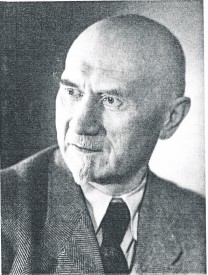ウォルター・クリッケベルク
Walter Krickeberg, 1885-1962

ウォルター・クリッケベルク
Walter Krickeberg, 1885-1962

★ウォルター・クリッケベルクは、アメリカの人類学者、「ミュージアムズマン」。1885年6月27日シュヴィーバス(ドイツ)生まれ、1962年7月15日ベルリン(ドイツ)死去。
| American
Anthropologist, "Museumsmann". Born Schwiebus (Germany) 27 june 1885,
died Berlin (Germany) 15 july 1962. Krickeberg started his academic
career in Berlin as student of American anthropology under Eduard Seler
[1849-1922]. In 1906 he was employed as "wissenschaftlicher
Hilfsarbeiter" at the Ethnographical Museum, which remained his
life-long institutional affiliation. Due to the First World War he got
his Ph. D. somewhat belated in 1922 and completed publication of his
important dissertation on the Totonacs in 1925 only. This was the first
synthetic monograph of archaeology, history and ethnology in
Mesoamerican research and has served as a model for later authors. Krickeberg was not a distinguished field worker (two sight-seeing trips to Mexico in 1939/40 and 1958/59), as most of his museum colleagues in the American section (Karl von den Steinen[ 1855-1929], Konrad Theodor Preuß[1869-1938] and Walter Lehmann [1878-1937]) were. Instead he was the leading writer of well informed overviews and synthetic monographs on general topics of the American Indian, during the first half of the 20th century. He started with two popular books on myths and legends, and general surveys of American Indian cultures for the handbooks of Georg Buschan [1863-1942] and Hugo Adolf Bernatzik [1897-1953]. |
ア
メリカの人類学者、「ミュージアムズマン」。1885年6月27日シュヴィーバス(ドイツ)生まれ、1962年7月15日ベルリン(ドイツ)死去。ベルリ
ンでエドゥアルド・ゼラー [1849-1922]
のもとでアメリカ人類学を学び、学問的なキャリアをスタートさせたクリッケバーグ。1906年、民族学博物館に
"wissenschaftlicher Hilfsarbeiter
"として採用され、この博物館が彼の生涯の所属機関となる。第一次世界大戦のため、1922年に博士号を取得し、1925年にトトナック族に関する重要な
論文を完成させた。この論文は、メソアメリカの研究において、考古学、歴史学、民族学を総合した最初のモノグラフであり、後の著者の模範となるものであっ
た。 クリッケベルクは、アメリカ部門の博物館の同僚たち(カール・フォン・デン・シュタイネン[ 1855-1929]、コンラート・テオドール・プロイス[ 1869-1938]、ヴァルター・リーマン[ 1878-1937] )のように優れたフィールドワーク(1939/40年と1958/59年の二度のメキシコへの観光旅行)者ではなかった。そのかわり、彼は20世紀前半に アメリカン・インディアンの一般的な話題について、十分な情報に基づいた概説書や総合的なモノグラフを書く第一人者であった。彼はまず、神話と伝説に関す る2冊の普及書と、Georg Buschan [1863-1942] と Hugo Adolf Bernatzik [1897-1953] のハンドブックのためのアメリカ・インディアン文化の一般調査から始まりました。 |
| One
of the best monographs of an American culture area to date is his
Altmexikanische Kulturen (1956). Late in his life he co-authored a
survey of American Indian religions and prepared a survey on rock art,
not completed during his lifetime (vol. I published by Krickeberg
himself in 1949, vol. I published posthumously by Karin Hahn-Hissink,
M.-B. Franke and Dieter Eisleb, 1969). These publications are all
characterized by his vast knowledge of basic facts and his diligent
perusal of current research as well as his outstanding ability to work
out general characteristics and historical trends for ethnic groups and
entire culture areas. Krickeberg adhered to the "kulturhistorische
Völkerkunde" more on the lines of Alfred L. Kroeber [1876-1960] and
Robert H. Lowie [1883-1957] than to the German "Kulturkreislehre". In
contrast to the American culture historical school, however, Krickeberg
was favorably inclined towards the notion of transpacific cultural
diffusion along the lines of Robert Freiherr von Heine-Geldern
[1885-1968] and Gordon Ekholm [1909-1987]. During the Nazi regime
Krickeberg mis-used his institutional power against colleagues
(controversy over the Lehrbuch für Völkerkunde) and employees of the
museum of which he was director. Nevertheless he was acquitted of all
accusals by the U.S. military government and was re-installed as
director of the Berlin Ethnographical Museum and as honorary professor,
posts he held until his regular retirement in 1954. (text written by Frauke Riese, by courtesy of Berthold Riese; photo source: Obituary by Hissink in Paideuma IX, 1963, pg. 79) |
ア
メリカ文化圏のモノグラフとしては、現在までに『アルトメキシカン・カルチャー』(1956年)が最も優れたものの一つである。晩年にはアメリカ・イン
ディアンの宗教に関する調査を共著で行い、生前には完成しなかった岩絵に関する調査を準備した(第1巻は1949年にクリッケベルク自身が出版、第1巻は
死後にカリン・ハーン=ヒシンク、M.-B. フランケ、ディーター・アイスレブが出版)。Franke and Dieter Eisleb,
1969)。これらの出版物はいずれも、基本的な事実に関する膨大な知識と最新の研究への熱心な目配りを特徴とし、民族や文化圏全体の一般的な特徴や歴史
的な傾向を解明する優れた能力を備えている。クリッケバーグは、ドイツの「文化史学」よりも、アルフレッド・L・クローバー[1876-1960]やロ
バート・H・ローウィ[1883-1957]の系統の「文化史学」を信奉していた。しかし、アメリカの文化史学派とは対照的に、ロバート・フライヘア・
フォン・ハイネ=ゲルデルン[1885-1968]やゴードン・エホルム[1909-1987]の太平洋を越えた文化伝播の概念に好意的であった。ナチス
政権下において、クリッケベルクは、自分が館長を務めていた博物館の同僚(Lehrbuch für
Völkerkundeをめぐる論争)や従業員に対してその組織力を悪用した。しかし、米軍政府によって無罪となり、ベルリン民族学博物館館長と名誉教授
に復帰し、1954年に定年退職を迎えるまでその職を務めた。 (文:Frauke Riese、写真:Berthold Rieseの好意により。写真出典:ヒシンクの訃報(Paideuma IX, 1963, pg. 79) |
| http://www.germananthropology.com/short-portrait/walter-krickeberg/186 |
|
| Walter
Krickeberg (* 27. Juni 1885 in Schwiebus (Neumark); † 15. Juli 1962 in
Berlin) war ein deutscher Amerikanist und Ethnologe. Sein
Arbeitsschwerpunkt waren die indigenen nord- und mesoamerikanischen
Kulturen und Religionen und die Altamerikanistik. Sein Lehrer war Paul
Ehrenreich. Von 1939 bis 1954 war er Direktor des Museums für
Völkerkunde in Berlin, daneben aber auch Mitherausgeber der
NS-Zeitschrift für Rassenkunde.[1] Einer breiten Öffentlichkeit bekannt wurde er durch seine Sammlungen Indianermärchen aus Nordamerika sowie Märchen der Azteken und Inkaperuaner, Maya und Muisca in der von Friedrich von der Leyen herausgegebenen Reihe Die Märchen der Weltliteratur. Er war Mitarbeiter zweier populärer und sehr verbreiteter Werke: der Illustrierten Völkerkunde von Georg Buschan, deren Amerika-Afrika-Band der zweiten Auflage er zusammen mit Richard Lasch und Arthur Haberlandt gestaltete, sowie der von Hugo A. Bernatzik herausgegebenen Großen Völkerkunde, wo er zusammen mit Herbert Tischner und Bernatzik den Australien-Amerika-Band gestaltet hat. Außerdem war er Mitglied der Berliner Gesellschaft für Anthropologie, Ethnologie und Urgeschichte und erhielt 1955 deren Rudolf-Virchow-Plakette. Während seines Studiums wurde er Mitglied beim Verein Deutscher Studenten Berlin.[2] |
Walter
Krickeberg, * 1885年6月27日 in Schwiebus (Neumark); † 1962年7月15日 in
Berlin)は、ドイツのアメリカニスト、民族学者である。北アメリカやメソアメリカの先住民の文化や宗教、古代アメリカ研究に力を注いだ。師匠はポー
ル・エーレンライク。1939年から1954年までベルリンの民族学博物館の館長であったが、ナチスの雑誌『Rassenkunde』の共同編集者でも
あった[1][2][3]。 フリードリヒ・フォン・デア・ライエン編『Die Märchen der Weltliteratur』シリーズで、北米のインディアン童話やアステカ、インカ・ペルー、マヤ、ムイスカの童話を収集し、広く一般に知られるようになった。 ゲオルク・ブシャンのIllustrierte Völkerkundeの第2版のアメリカ-アフリカ編をリチャード・ラッシュ、アーサー・ハバーラントとともにデザインし、ヒューゴ・ベルナツィク編集 のGrosse Völkerkundeのオーストラリア-アメリカ編をハーバート・ティシュナー、ベルナツィクとともにデザインしたのである。また、ベルリンの人類学・ 民族学・先史学会の会員でもあり、1955年には同学会のルドルフ・ヴィルヒョー記念楯を授与されている。 在学中、ベルリン・ドイツ学生同盟のメンバーとなる[2]。 |
| https://de.wikipedia.org/wiki/Walter_Krickeberg |
|
+++
Links
リンク
文献
その他の情報


